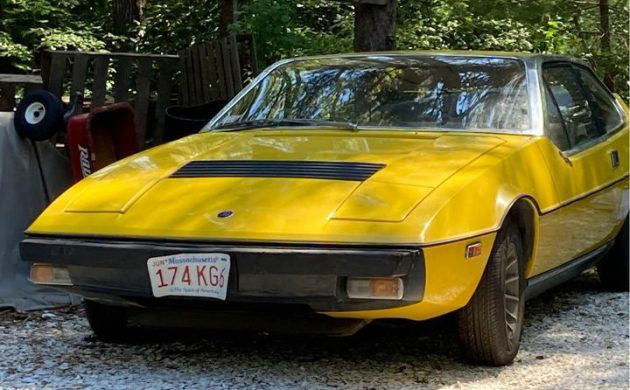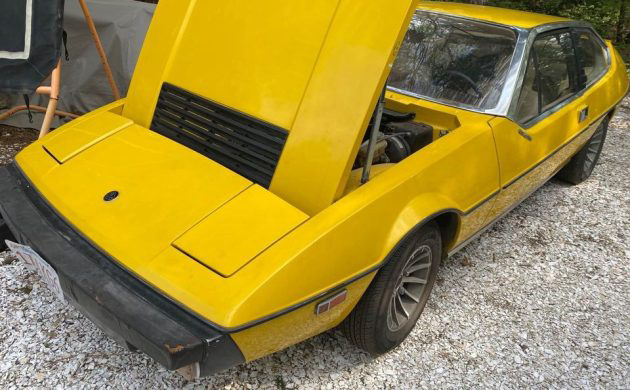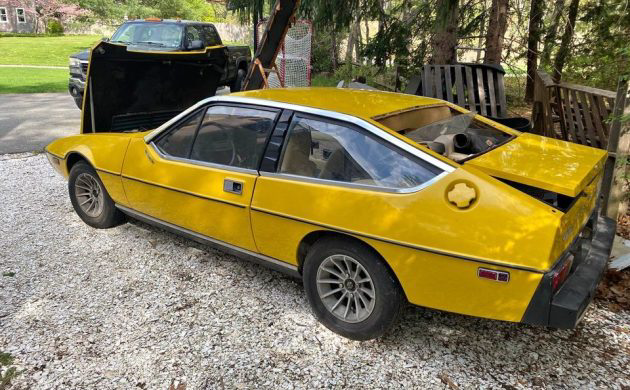It’s an irony that cars resulting from Lotus’ efforts to move upscale should be found in consistently derelict condition. No one seemed to care about the Elite and Éclat four-seat models once they had racked up enough miles to qualify as “used”. Oliver Winterbottom designed both models, hewing to the new angular design idiom so popular in the 1970s. No longer were cars delivered from Lotus in kit form – a practice that was disadvantage by a change in taxation. The Elite arrived first, in 1974, as a sporty estate – an unusual niche. The Éclat was the hatchback version. The example we’re covering today is located in Duxbury, Massachusetts, does run and drive, and has all the parts and manuals to bring this project past the finish line. It is advertised here on facebook Marketplace for $5000, and Chuck Foster submitted the tip so we could review it – thanks, Chuck!
This listing’s photos are sparse, so a call might be required to clear up a few questions. For instance, this is the best photo we’re provided showing the engine bay. Yes, unlike the Europa, the Éclat is a front-engine, rear wheel drive layout … The engine is the same as the 1973 cc twin-cam four-cylinder found in the Jensen-Healey, albeit a bit better-behaved. (The advent of this new-to-Lotus engine gave the Jensen-Healey a poor reputation from the git-go.) Making about 160 hp in Euro-delivered trim with twin Dell’Orto carbs, and 145 hp over in the US cars where the 907 breathed through two Zeniths, the engine made it to sixty in less than seven seconds. Later engines were larger but granted no increase in horsepower thanks to emissions controls. This gearbox is a four-speed manual.
The seller notes that the interior and gauges need to be installed; other than the photo above, we are given no views of the interior. Looks like portions of the glass are not in place either. The after-market wheels could use refinishing. Front discs and in-board rear drums brought the light-weight car down from its top speed of over 120 mph; later Éclats had slightly larger brakes. The fiberglass body alleviates concerns about rust, but the steel frame deserves scrutiny.
The wedge design persisted for years in the Lotus portfolio, influencing the Excel – a follow-on to the Éclat – and the Esprit – launched in 1976 – for more than two decades. The viable population of Éclats is slender – only 1522 were sold to begin with, and as noted, few were cherished after service. This casual attitude traces to the initial lukewarm reception as customers tried to puzzle out whether Lotus was still in the sports car business, or had turned to the family market for good. That question was eventually answered by later iterations of the Esprit – but that’s a story for another time.






I owned a red 77 Elite, yes i know say what you want. Only four poor photos, and can you get a little farther back?
Being a fan of weird and unloved, I’d definitely sign up to own one of these, if only I could find an example in better condition. They are rare as hen’s teeth.
I know, those photos – yikes! How hard is this in the days of cameras on nearly every cell phone and plenty of scope to post them in any ad venue for free.
Hood open but no engine shots, grungy wheels, mangled license plate, and no interior shots. This seller is really no used car salesperson.
The 501 Elite was where Lotus lost the plot. Before that, Chapman hadn’t really put a foot wrong. But i remember as a teenager with my car chum ( who actually could afford Lotus Elans as a teenager) being so disappointed by the look and spec of the Lotus Elite.
I don’t think anyone managed to make money with premium market fibreglass cars. I don’t remember Winterbottom designing anything remotely attractive. I remember the interior of thes cars falling apart too quickly.
Having said that, the Éclat is the best of the bunch.
Surprised the styrofoam rubber bumper pieces are still glued to the car.